The story begins with a young person, just 16, diving into the world of interior design. They started learning on their own with books like Domino’s Book of Decorating and Elements of Style. Later, they worked at an interior design blog. There, they discovered designers using tools like Google Slides and Photoshop to make room mockups.
Google Slides is a free tool that’s easy for anyone to use. It works a lot like PowerPoint or Keynote but is better for team projects. You can change designs quickly, which is perfect for planning children’s rooms. With Google Slides, you can see how a room will look in 2-D. This makes picking a design faster, without having to move a single piece of furniture.

Key Takeaways
- Google Slides and Photoshop are valuable tools for virtual room design mockups.
- Using Domino’s Book of Decorating and Elements of Style can inspire innovative room planning.
- 2-D mockups in free tools aid in making swift and efficient design decisions.
- This method enhances the design process for kid-friendly interiors.
- Visualizing room evolution is crucial for children’s space adaptation.
Understanding the Needs of Growing Children
When children move from preschool to school, they become more independent. They need spaces for their new activities like reading and socializing. It’s important to know what kids at different ages like and need.
Creating Functional Zones
To meet children’s needs, create different zones. Have quiet spots for study, fun areas for play, and places for group work. This approach helps kids do their best in activities fitting their age.
Functional and Adaptive Furniture
Children need furniture that’s comfy and right for their activities. Options include flexible seating for reading and movable shelves. Proper tables for schoolwork also matter. This way, kids can learn and play in a space that grows with them. Adding creative things like magnetic poetry helps them think and solve problems.

Leveraging Online Interior Design Tools
Online interior design tools offer great flexibility and vision for planning rooms. They’re key in making spaces that grow with kids.
Using Google Slides for Design Mockups
Google Slides is easy to use and great for digital design mockups in 2-D. It makes quick changes possible, showing many layouts for kids’ rooms. It’s so simple that anyone can use it, really improving how spaces are planned.
Exploring 3D Design Platforms like HomeByMe
For a deeper 3D room planning experience, HomeByMe shows rooms come to life. You can change furniture, colors, and materials in 3D. This way, kids can help plan their rooms in a way that’s both fun and a learning experience.

Benefits of Online Interior Design
Using innovative design platforms like Google Slides and HomeByMe has many benefits. They help create flexible spaces for children. This means less need for big changes later. Plus, these technology in interior design tools boost creativity. They let families see many options before deciding.
Conclusion
Today, digital tools offer a great way to learn about interior design. Tools like HomeByMe make creating kids’ spaces easy and fun. They consider every part of a child’s needs.
Using Google Slides or HomeByMe, anyone can design a child’s room with ease. This makes the room not only look good but also meet a child’s changing needs. These tools show clear layouts and changes, reducing stress.
Online design tools provide solutions that keep up with a child’s growth. They make rooms that support and encourage children as they grow. This way, every child’s room can be perfect for them at any age, thanks to these modern tools.
FAQ
What are the primary motivations for learning about interior design?
Many people want to make their homes look better. For instance, a 16-year-old will start learning about interior design by themselves. They might use resources like Domino’s Book of Decorating. Later, they could work at an interior design blog.
How are accessible tools like Google Slides utilized in interior design?
Google Slides is simple to use and free. It has features similar to PowerPoint. This tool helps people work together easily. You can quickly change room designs with it, which is perfect for virtual designs.
Why is visualizing a room’s design in 2-D beneficial?
Seeing a room in 2-D gives clear views and aids quick design choices. This avoids making physical changes too soon. It’s very useful, especially for planning children’s rooms.
How should spaces be designed for children as they grow?
As kids grow, their rooms should change too. It’s key to know what they need at different ages. The rooms should have areas for studying, playing, and hanging out.
What is important to consider when choosing furniture for children’s rooms?
Pick furniture that fits many needs and is safe. Look for chairs and shelves that can move and change. The right size tables and chairs can make learning and playing better.
How can interactive elements be incorporated into children’s rooms?
Put in fun and educational things like magnetic words. Or try DIY science projects. These ideas can make the room more interesting and help kids learn new things.
What are the benefits of using online interior design tools for room planning?
Internet tools like Google Slides help change a room as your child grows. They also get your child involved in designing. These tools let kids see their ideas come to life.
How does HomeByMe enhance room planning?
HomeByMe lets you plan in 3D and see everything realistically. You can try out different furniture, colors, and materials. It makes designing fun and interactive.
What are the overall benefits of online interior design?
Online design tools and 3D planning make designing easy and fun. These help families create spaces that change with their children. This way, rooms can always meet their needs.

